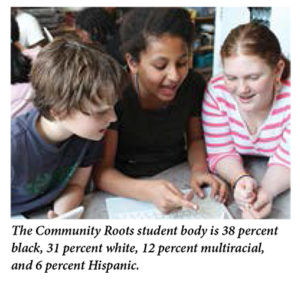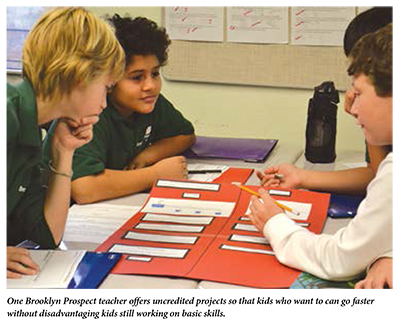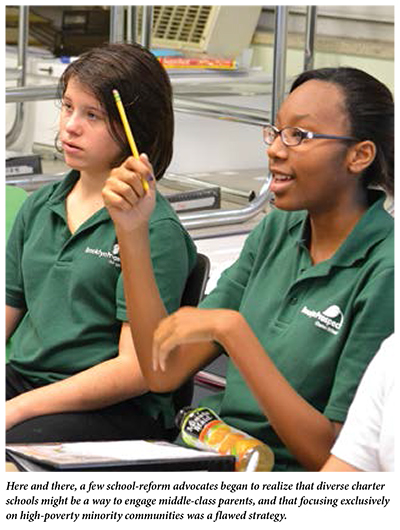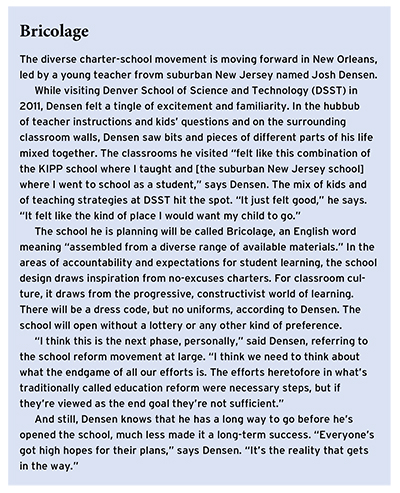
In February 2009, newly elected President Barack Obama and First Lady Michelle Obama visited Capital City Public Charter School in northwest Washington, D.C. They were greeted at the front entrance of the school by 5th-grade students and given a brief tour before taking a seat in the library to read The Moon Over Star to a group of 2nd graders.
This was the First Family’s first official public-school visit, just a few short weeks after President Obama was sworn into office. Obama’s enthusiastic support for charter schools was one of the things that set him apart from his Democratic predecessors and marked him as a “pro-reform” Democrat.
Even accounting for the usual political exaggeration, the president seemed pretty impressed by what he saw: “The outstanding work that’s being done here…is an example of how all our schools should be,” said Obama. “I’ve asked Arne Duncan to…make sure that we’re reforming our schools, that we’re rewarding innovation the way that it’s taking place here.”
Little noticed at the time, the school the White House chose for the visit wasn’t exactly a typical urban charter. Based on the Expeditionary Learning model and begun by a group of parents in 2000, Capital City is located in an ethnically and socioeconomically diverse part of northwest Washington, rather than in a high-poverty area. It recruits a mix of black, Latino, and white families, in contrast to the homogeneous groups of low-income minority students urban charters generally serve. Last but not least, its teaching approach is designed to work with both advanced and struggling students, and intended to foster abstract skills like creativity, depth of thought, and problem solving, rather than focusing on remediation and basic reading and math skills.
Fueled by a confluence of interests among urban parents, progressive educators, and school reform refugees, a small but growing handful of diverse charter schools like Capital City has sprouted up in big cities over the past decade: others are High Tech High in San Diego; E. L. Haynes in Washington, D.C.; Larchmont Charter School and Citizens of the World Prep in Los Angeles; Summit in Northern California; the five-school Denver School of Science and Technology (DSST) network; Community Roots, Brooklyn Prospect Charter School, and Upper West Success Academy in New York City; and Bricolage Academy, planned for New Orleans (see sidebar, page 33).
These schools attract children of city workers, project residents, New York Times reporters, and government officials, and simultaneously attempt to address the weaknesses of “no-excuses” charter schools, progressive education, and school segregation: “Usually in the places that are all about accountability it doesn’t feel like there is a ton of learning going on as the primary outcome,” says Josh Densen, a former KIPP teacher who is set to open Bricolage Academy next year. “In schools where it’s all about learning, discovery, and projects and teamwork, there seems to me to be an absence of or a reluctance to have any kind of accountability.”
While it is too soon to say whether they are effective over time or at scale, these diverse charter schools are revealing themselves to be popular, controversial, and—not surprisingly—complicated to operate.
Diversity at Community Roots
 On a sunny fall afternoon, a group of 5th graders at Community Roots in Fort Greene, Brooklyn, looked over a short passage about the Montgomery bus boycott, practicing how to find extra information in captions and headlines. Some were struggling to get started or needed a review of the basic concepts from one of the two teachers in the room. Others zoomed ahead and were encouraged to think about more advanced ideas like inference and themes. Some had on fashionable ankle boots, while others wore threadbare T-shirts. Their names ranged from Gabe to Ilios to Amira to Bella.
On a sunny fall afternoon, a group of 5th graders at Community Roots in Fort Greene, Brooklyn, looked over a short passage about the Montgomery bus boycott, practicing how to find extra information in captions and headlines. Some were struggling to get started or needed a review of the basic concepts from one of the two teachers in the room. Others zoomed ahead and were encouraged to think about more advanced ideas like inference and themes. Some had on fashionable ankle boots, while others wore threadbare T-shirts. Their names ranged from Gabe to Ilios to Amira to Bella.
Created in 2005, Community Roots is housed on the third floor of P.S. 67, Dorsey Elementary School, which is surrounded by a church, a post office, and the sprawling Ingersoll Gardens housing project. Its students come from some of the highest and lowest income brackets in the city, range from gifted to severely behind, and are largely taught together in the same classrooms. The student body is 38 percent black, 31 percent white, 12 percent multiracial, and 6 percent Hispanic. Forty-four percent qualify for free lunch. Almost 20 percent receive special education services.
Teachers use many of the same methods and materials you’d see in traditional charters: math manipulatives, relentlessly positive reinforcement, claps and countdowns to help with transitions from one activity to another, walls covered with concepts and procedures. But there are some obvious differences: two teachers are assigned full-time to each classroom, one of them certified in special education, to make sure every student is getting the help (or the push) he or she needs. The school offers physical therapy along with a social studies–oriented curriculum. While the atmosphere is informal, the teachers are deadly serious about helping every kid, including the numerous special-education students, learn.
“We try to provide access to the content of the lesson on as many different levels as possible,” says David Moisl, a 2nd-grade teacher. “On an average day, I think we’re getting to all the kids.” Reaching everyone, and knitting parents and students into a community, doesn’t end at the classroom door. Community Roots schedules play dates—for parents. Four times a year, mixed-income groups of parents in each class get together, either at the park or in one of their homes or on some sort of field trip.
“It doesn’t mean they’re all going to be best friends,” says one parent who helps promote the get-togethers. “There’s this acceptance the more they get to know each other, real understanding that we’re all different, learn differently, play differently, and that’s OK.”
Engaging the Middle Class
 Looking back, the reasons that schools like Capital City and Community Roots are being created and attracting flocks of parents seem obvious: a mix of idealism, desperation, and pent-up frustration with the pace of improvement and the focus on a fixed set of interventions.
Looking back, the reasons that schools like Capital City and Community Roots are being created and attracting flocks of parents seem obvious: a mix of idealism, desperation, and pent-up frustration with the pace of improvement and the focus on a fixed set of interventions.
By the time the First Family visited Capital City in early 2009, No Child Left Behind was already seven years old, long overdue for an update. A series of highly touted reform ideas—small schools, alternative certification, “no-excuses” charter schools, higher academic standards, and better accountability for teachers and administrators—had helped but not yet transformed the nation’s $600 billion, 50-million-student elementary and secondary education system.
“It’s about time that we get a new surge of energy in the ed reform movement,” says Todd Sutler, who until recently taught at Community Roots. “There needs to be something fresh.”
In the meantime, some traditional educators who have long derided charter schools started to come around to the notion that charter autonomy was an extremely useful thing. “I think that this [charter] model is the only model that can be principled and serve the needs of kids,” says Tony Monfiletto, a progressive educator who cofounded the Amy Biehl Charter High School in Albuquerque, New Mexico. “You have to have the autonomy.”
In urban areas especially, the supply of good schools hasn’t nearly kept pace with the demand, and the old standbys for middle-class parents (moving or paying private school tuition) have become less viable options in a “down” economy going through a housing crisis. Magnet schools, once a core strategy for retaining middle-class parents and promoting school integration, have dwindled to just 2,000, according to the National Association of Magnet Schools. Just 80 districts and charter school networks are actively promoting integration, according to a 2011 report from the Century Foundation’s Richard Kahlenberg.
Here and there, a few school-reform advocates began to realize that diverse charter schools might be a way to engage middle-class parents, and that focusing exclusively on high-poverty minority communities was an understandable but flawed strategy.
“Is this when things start to really change?” asks a Brooklyn mother of three who has been working in education for nearly 20 years, “When upper-middle-class charter parents start bragging to their friends?”
No Easy Feat
 A newly created charter school with a focus on diversity has the flexibility and responsiveness that comes with charter status. Its parents know what they are getting into from the start. There’s no “gentrification gap” during which a neighborhood school is losing its poverty funding but doesn’t yet have enrichment grants (and, typically, parent contributions) to make up the difference (see “The Elephant in the Classroom,” features, Winter 2013). They’re schools that educators can imagine spending an entire career at, or even sending their own kids to. And, at the best moments, being in a public school classroom of kids with diverse backgrounds and skill levels is delightful and unnerving, a busy kitchen humming during the dinner rush, a blur of individual activities brought together only momentarily before splitting apart again.
A newly created charter school with a focus on diversity has the flexibility and responsiveness that comes with charter status. Its parents know what they are getting into from the start. There’s no “gentrification gap” during which a neighborhood school is losing its poverty funding but doesn’t yet have enrichment grants (and, typically, parent contributions) to make up the difference (see “The Elephant in the Classroom,” features, Winter 2013). They’re schools that educators can imagine spending an entire career at, or even sending their own kids to. And, at the best moments, being in a public school classroom of kids with diverse backgrounds and skill levels is delightful and unnerving, a busy kitchen humming during the dinner rush, a blur of individual activities brought together only momentarily before splitting apart again.
But creating a successful, truly diverse charter school is enormously difficult to pull off, a daily and weekly high-wire act that only the most determined educators are confident or foolish enough to try. The wide range of abilities and backgrounds creates obvious challenges: “the kids who know about therapods, and the kids who can’t pronounce the word ‘dinosaur,’” said an Upper West science teacher. Careful design, highly skilled teaching, and a degree of compromise among teachers and parents who come from different cultures and professional backgrounds are all required.
Indeed, the list of strategies applied is a long one: frequent online assessments to diagnose and direct students to the appropriate activity; open-ended assignments allowing kids of varying skill levels to engage at their own levels; coteaching in which two teachers share responsibility for a group of kids; and looping, in which teachers follow kids from one grade to the next.
“Everybody likes diversity until it comes to the ramifications,” says Daniel Rubenstein, cofounder of Brooklyn Prospect, a middle and high school now in its fourth year.
In one Brooklyn Prospect classroom, the English teacher makes as many of her lessons open-ended as she can and coteaches half of her classes with a special education teacher. She also offers additional uncredited projects called “Seekers” so that kids who want to can go faster without disadvantaging kids still working on basic skills. The kids who volunteer to do more aren’t always the kids with the stronger academic backgrounds. “That is the really cool thing,” says the teacher. “You think you know who’s going to ask to do the extra assignment, but then you’re wrong.”
At their worst, classes at diverse charters feel choppy and fragmented, like a PowerPoint presentation with too many slides or a TV show with too many unrelated strands of plot, leaving advanced kids bored and struggling kids feeling anxious. Teachers are trying to reach too many kids too quickly. Classrooms may exhibit the features of progressive education—the projects, the integrated curriculum—but lack the rigor and attention required to keep fast kids humming and slow kids engaged.
“You can’t just put a heterogeneous population together and think it’s going to work,” notes Summit founder Diane Tavenner, speaking generally. “That’s why most schools are tracked.”
Maintaining the Mix
 When TFA Los Angeles executive director Brian Johnson first walked into Larchmont Charter School, he realized that he’d never seen a school like it before.
When TFA Los Angeles executive director Brian Johnson first walked into Larchmont Charter School, he realized that he’d never seen a school like it before.
Begun in 2005 and expanded in 2008, Larchmont was created by Hollywood and Hancock Park parents who lamented the lack of quality and diversity at local elementary schools and wanted an alternative to private education. The educational philosophy is constructivist, which means lots of small-group instruction, projects, and integration of subjects traditionally taught in isolation. Classes are small. There is a teaching garden. There are lots of readers’ and writers’ workshops.
Accustomed to working almost exclusively in high-poverty schools in far-off neighborhoods, Johnson was attracted by the idea of doing something in his own community and getting involved in an approach that he described as “strategically important to the reform movement.”
When Johnson left TFA and joined Larchmont as its executive director, however, the school was facing a challenge experienced by many diverse charter schools: the annual admissions lottery was being flooded by white, relatively well-off parents, creating the danger that the school would lose the socioeconomic and racial diversity it was created to promote.
The strategies that diverse charters adopt to promote and protect diversity vary. Some, like Larchmont, implement lottery priority systems designed to give at-risk students a better chance of acceptance even if they apply in smaller numbers. Larchmont’s at-risk priority increased the percentage of poor kids from a low of 29 percent up to 42 percent. Schools now using various kinds of weighted priority systems include Brooklyn Prospect, DSST, Upper West Success, and Community Roots.
Other schools, including Capital City and Summit Prep, maintain diversity through aggressive recruitment efforts: school visits, knocking on doors, distributing flyers. The 2009 Obama visit to Capital City led to a spike in applications (1,500 for 100 spots in 2011), but still there was no weighted lottery. Even after the surge of interest following its 2010 Waiting for Superman appearance, Summit Prep continues to operate without lottery priorities.
There are lots of reasons to avoid weighted lotteries, which have to comport with underlying city and state requirements (and stand up to a potential legal challenge). Adopting a weighted lottery or priority system also means giving up a chance at federal charter-school start-up funding, which is limited to schools with a single lottery. Most immediately, weighted lotteries and priorities create the possibility for mistrust.
“There are plenty of people who already doubt what we’re doing,” says Summit founder Diane Tavenner. “We don’t want to give them any more reasons to be confused.”
Critical Backlash
In September 2011, Success Academy opened its newest location inside an Upper West Side Manhattan high-school building, marking the first attempt by an established charter network to try its hand at the diverse model. Dubbed “Upper West,” the school’s students wear orange-and-blue uniforms complete with jumpers and clip-on ties, just like at the other locations. There is absolutely no talking in the hall. But there’s also chess, time to play with wooden blocks, outside recess, and daily science class. The model is, according to Success Academy officials, “Parochial on the outside, progressive on the inside.”
In one 1st-grade classroom, red-haired Maddie sat next to Mohawked Taquan. Scraggly-haired Alex read on the carpet while little Mariella filled out her reading log. The grown-ups who come to pick up the children at the end of the day include parents, older siblings, and nannies.
Success Academy plans to operate 40 schools in total, and its expansion into middle-class neighborhoods—the Upper West Side last year, Brooklyn this year—has pushed concerns into overdrive. Charter schools have long been accused of perpetuating racial isolation, relying on uncertified teachers, and not serving their fair share of special education and English language learners. Now the concerns center around white, middle-class kids and the schools they are leaving to attend charters.
 ”Why not use that same money to try to turn some of Brooklyn’s less-popular elementary schools into institutions that…attract parents from across the socioeconomic spectrum?” wrote a Brooklyn parent opposed to Success Academy’s expansion.
”Why not use that same money to try to turn some of Brooklyn’s less-popular elementary schools into institutions that…attract parents from across the socioeconomic spectrum?” wrote a Brooklyn parent opposed to Success Academy’s expansion.
This argument resonates with many middle-class parents, who clutch to their hope to win admission to a “good” district school, no matter how unlikely that may be. Many also have political objections to nonunion charters. They often lack personal familiarity with charter schools, and they’re unused to hearing that their neighborhood schools aren’t succeeding.
“Middle-class communities don’t want to be told that the options they have are not good enough,” notes Success Academy’s Jenny Sedlis. “There’s an unwillingness to accept the fact that their schools are just not excellent.”
These concerns can increasingly be seen in the mainstream media. Recent accounts have tended to emphasize the downsides of diverse charter schools, and the controversy. Bloomberg News profiled a charter school in affluent Los Altos, California, accused of failing to serve its fair share of bilingual and special education students. The LA Weekly revealed a short-lived initiative to give wealthy parents spots at Larchmont by rotating them through the board (whose members get a priority for admission).
Some critics worry that schools that appeal to middle-class parents can’t effectively serve kids from disadvantaged backgrounds. Only a few diverse charter schools, like Rhode Island’s Blackstone Valley Prep, have been able to attract middle-class families without using progressive elements, either superficially to help promote diversity or structurally as part of the core pedagogical vision. Research has generally shown that racially and socioeconomically diverse schools can help low-income, low-skill students improve their academics. But a 2010 U.S. Department of Education charter-school study found that suburban charters, presumably with progressive elements, performed less well than comparable district schools.
What’s Next?
Brooklyn’s Community Roots has been approved to expand into middle school this fall and considers its new lottery priority a success: roughly 600 families applied for a kindergarten class of 50. Los Angeles–based Citizens of the World has been approved to open a school in Brooklyn’s Williamsburg neighborhood, along with two Brooklyn Success Academy schools. Brooklyn Prospect is moving to a new, permanent home and enrolling its first class of 9th graders.
The Obama administration has issued new priorities for its charter-school grant program, among them support for schools that “promote diversity in their student bodies, including racial and ethnic diversity, or avoid racial isolation.”
Education philanthropies have finally started to take diverse charters seriously, too. Among the first to receive funding was DSST, whose head, Bill Kurtz, pushed for several years to be funded and viewed like any other successful charter-management organization. According to Kurtz, funders including Walton, Charter School Growth Fund, and NewSchools Venture Fund now support diverse charters at some level.
“What is the [charter] movement going to do for the 98 percent of American kids who aren’t going to our schools?” asks Kurtz, who previously headed a traditional charter in Newark, New Jersey. “People who come to DSST are often asking, ‘What’s next?’”
Alexander Russo is a freelance education writer and blogger who lives in New York City. An expanded version of this article will appear in his next book, School of Politics.
This article appeared in the Winter 2013 issue of Education Next. Suggested citation format:
Russo, A. (2013). Diverse Charter Schools: Popular, controversial, and a challenge to run successfully. Education Next, 13(1), 28-34.


